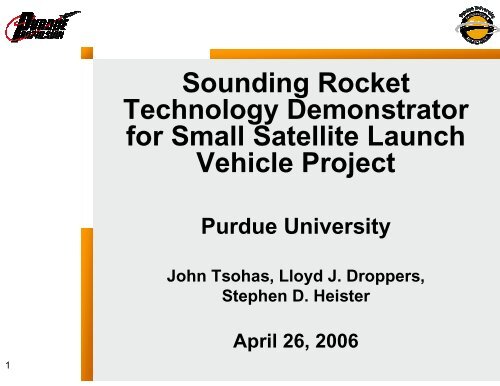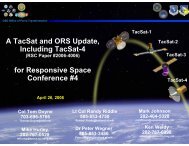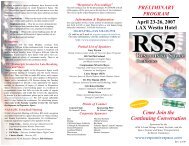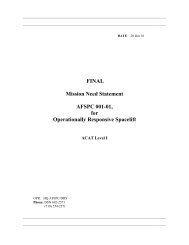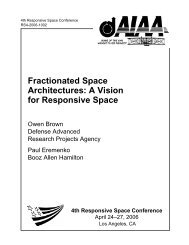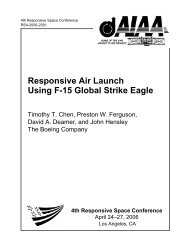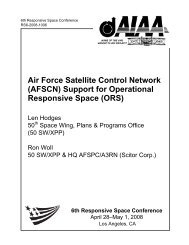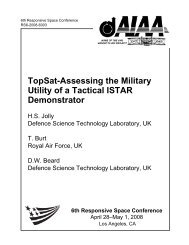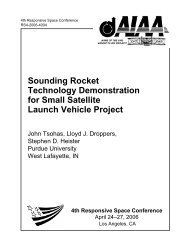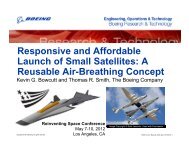Sounding Rocket Technology Demonstrator for Small Satellite ...
Sounding Rocket Technology Demonstrator for Small Satellite ...
Sounding Rocket Technology Demonstrator for Small Satellite ...
Create successful ePaper yourself
Turn your PDF publications into a flip-book with our unique Google optimized e-Paper software.
<strong>Sounding</strong> <strong>Rocket</strong><br />
<strong>Technology</strong> <strong>Demonstrator</strong><br />
<strong>for</strong> <strong>Small</strong> <strong>Satellite</strong> Launch<br />
Vehicle Project<br />
Purdue University<br />
John Tsohas, Lloyd J. Droppers,<br />
Stephen D. Heister<br />
1<br />
April 26, 2006
Purpose & Goals<br />
• Develop technologies critical to launch vehicle<br />
development<br />
• Phase 1: Design/Build <strong>Sounding</strong> <strong>Rocket</strong><br />
<strong>Technology</strong> <strong>Demonstrator</strong><br />
– 5 lb payload to 25,000 ft<br />
– Test-bed <strong>for</strong> critical sub-systems including<br />
ground support, propulsion, structures,<br />
separation, guidance, navigation and control.<br />
– Sequential flight validation of sub-systems.<br />
• Phase 2: Design of small satellite launch vehicle<br />
– 10 lb payload to LEO (93 mi. orbit).<br />
– Use technologies demonstrated in Phase 1.<br />
– 3 stages, hybrid propulsion (H 2 O 2 /HTPB), low<br />
propellant mass fraction design<br />
2
Overview of <strong>Sounding</strong> <strong>Rocket</strong> <strong>Demonstrator</strong><br />
3<br />
• Propulsion:<br />
– 250 lbf thrust 90% H 2<br />
O 2<br />
/HTPB hybrid,<br />
pressure-fed system.<br />
– H 2<br />
O 2<br />
: high density Isp, non-cryogenic,<br />
non-toxic, safe propellant handling,<br />
reduces complexity/operations costs.<br />
• Structure:<br />
– Carbon-fiber composite airframe<br />
– Aluminum oxidizer pressure vessel<br />
– Fiber-glass internal structure,<br />
honeycomb fins.<br />
• Recovery:<br />
– Dual pyrotechnic parachute<br />
deployment (primary/drogue)<br />
– Redundant recovery system avionics.<br />
• Ground Support Equipment:<br />
– Remote fill/draining of hydrogen<br />
peroxide to and from vehicle<br />
– Remote control and monitoring of<br />
sounding rocket launch operations.<br />
• Guidance and Control:<br />
– Liquid injection thrust vector control<br />
(LITVC) technology in development<br />
– Flight verification in subsequent flights
Propulsion<br />
4<br />
• Sub-scale, 25 lbf Thrust Engine<br />
– Hot fire testing to characterize<br />
HTPB regression rate with<br />
90% H 2 O 2<br />
– Validation of internal ballistics<br />
engine design code<br />
– Data used <strong>for</strong> design of full<br />
scale engine<br />
• Full-scale,170 lbf Thrust Engine<br />
– Flight weight engine design<br />
– 440 psia MEOP, 5.25 avg. O/F<br />
ratio.<br />
– Internal phenolic liner <strong>for</strong><br />
casting HTPB and insulation<br />
– Butt-seal design, and<br />
secondary o-ring seal<br />
– Silica-phenolic nozzle<br />
– Carbon-filled EPDM and RTV<br />
insulation<br />
– Consumable Catalyst Bed<br />
used <strong>for</strong> ignition of H 2 O 2 /HTPB<br />
– 218 second ISP (sea-level,<br />
moderately over-expanded)<br />
Chamber Pressure<br />
Thrust<br />
Oxidizer Mass Flow Rate<br />
Initial O/F ratio<br />
Predicted average c*<br />
Fuel Grain Outer Port<br />
Diameter<br />
Fuel Grain Length<br />
440<br />
175<br />
0.68<br />
5.25<br />
4900<br />
3.5<br />
10<br />
[psi]<br />
[lbf]<br />
[lbm/s]<br />
[ft/s]<br />
[in]<br />
[in]<br />
Injector Assembly<br />
Combustion Chamber<br />
Top Cap<br />
Consumable<br />
Catalyst Bed<br />
Aluminum<br />
Motor Casing<br />
HTPB Fuel<br />
Grain<br />
Aft Mixing<br />
Section<br />
Paper Phenolic<br />
liner<br />
Silica Phenolic<br />
Nozzle<br />
Viton O-ring<br />
Nozzle<br />
Retaining Ring
5<br />
Sub-scale 25 lbf Thrust Engine Hot Fire Testing
Structure Sub-system<br />
6<br />
• Carbon-fiber, 6” diameter<br />
airframe<br />
• Aluminum oxidizer<br />
pressure vessel<br />
(MEOP=600 psia)<br />
• Burst pressure F.S.<br />
2 X MEOP<br />
• Proof tested to<br />
1.5 X MEOP<br />
• Vibration tests scheduled<br />
• Fiber-glass nose cone<br />
and internal structure<br />
design<br />
• Honeycomb fin design<br />
• Per<strong>for</strong>med Finite Element<br />
Analysis on major<br />
components
Ground Support Equipment<br />
• Remote fill/drain of H 2 O 2 to and from vehicle<br />
• Remote control of solenoid valves with Labview software<br />
• Regulated nitrogen pressure used to transfer H 2 O 2 from<br />
storage tank to rocket oxidizer tank through series of<br />
solenoid valves (600 psia MEOP).<br />
• <strong>Rocket</strong> oxidizer tank temperature and pressure monitored<br />
to ensure safe condition of H 2 O 2<br />
• Fail-safe design: In event of power outage, valves return to<br />
normal positions, automatically venting tanks and draining<br />
oxidizer from launch vehicle<br />
7
Design Philosophy of <strong>Small</strong> Launch Vehicle<br />
• Primary driver <strong>for</strong> universities is to provide student<br />
body with education and practical engineering<br />
experience to design, build and fly small launch<br />
vehicle into LEO<br />
• ‘In series’ manufacturing and flight verification of<br />
each stage individually will help work out kinks in<br />
sub-systems, without placing entire integrated<br />
vehicle at risk.<br />
• Serial development will allow each generation<br />
(class) of student designers to work from inception<br />
to completion of project while still being students<br />
(each launch vehicle stage).<br />
• Relatively low propellant mass fraction will allow <strong>for</strong><br />
student design, and local manufacturing.<br />
8
Conceptual Design of <strong>Small</strong> Launch Vehicle<br />
• Trajectory, aerodynamics,<br />
and vehicle sizing codes<br />
developed <strong>for</strong> initial design<br />
• Design constraints:<br />
– 10 lb payload, to<br />
minimum 93 mi LEO<br />
orbit.<br />
– Pressure fed system<br />
design<br />
– 10,000 lbf max. thrust<br />
based on Purdue test<br />
capabilities.<br />
– ISP and engine<br />
perfrormance data from<br />
Phase 1 testing.<br />
9<br />
M tot stg1 M prop stg1 M i stg1 M tot stg2 M prop stg2 M i stg2 M tot stg3 M prop stg3 M i stg3 M payload M GLOW<br />
5397 4156 1241 786.9 605.9 180.7 81.2 62.5 18.7 10.0 6275.1<br />
86%<br />
GLOW<br />
77%<br />
STG1<br />
23%<br />
STG1<br />
12.5%<br />
GLOW<br />
77%<br />
STG2<br />
23%<br />
STG2<br />
1.3%<br />
GLOW<br />
77%<br />
STG3<br />
23%<br />
STG3<br />
0.16%<br />
GLOW<br />
(mass in lbs)
Conceptual Design of <strong>Small</strong> Launch Vehicle<br />
10<br />
• Stage 3:<br />
– SRM propulsion<br />
– <strong>Satellite</strong> release mechanism<br />
– Avionics module<br />
• Stage 2:<br />
– 1,230 lbf thrust, 98%<br />
H 2 O 2 /HTPB hybrid motor<br />
– Burn duration: 157 sec<br />
– ISP: 320 sec(avg)<br />
– Chamber pressure: 200 psia<br />
– LITVC thrust vector control<br />
– Carbon-fiber composite<br />
structure<br />
• Stage 1:<br />
– 8,790 lbf thrust, 98%<br />
H 2 O 2 /HTPB hybrid motor<br />
– Burn duration: 123 sec<br />
– ISP: 260 sec<br />
– Chamber pressure: 600 psia<br />
– LITVC thrust vector control<br />
– composite structure.<br />
– Parachute recovery<br />
– Novel altitude compensation<br />
Stage 2 mass breakdown:<br />
Ullage Mass, lbm 15.1 8.4%<br />
Oxidizer Tank mass, lbm 16.2 9%<br />
Engine Mass, lbm 28.1 15.6%<br />
Pressurant Mass, lbm 5.5 3%<br />
Pressurant tank, lbm 16.8 9.3%<br />
Structural Mass, lbm 18.1 10%<br />
Miscellaneous mass, lbm 27.1 15%<br />
Mass Growth, lbm 53.8 29.7%<br />
Stage 2 Total Mass, lbm 180.7 100%<br />
Stage 1 mass breakdown:<br />
Ullage Mass, lbm 103.9 8.37%<br />
Oxidizer Tank mass, lbm 201.6 16.2%<br />
Engine Mass, lbm 281.1 22.6%<br />
Pressurant Mass, lbm 69.7 5.6%<br />
Pressurant tank, lbm 230.7 18.6%<br />
Structural Mass, lbm 124.1 10%<br />
Miscellaneous mass, lbm 124.1 10%<br />
Mass Growth, lbm 105.9 8.5%<br />
Stage 3Total Mass, lbm 1241 100%
Conclusions<br />
11<br />
Phase 1:<br />
• Development of sounding rocket technology demonstrator<br />
<strong>for</strong> flight verification of critical sub-systems <strong>for</strong> small<br />
launch vehicle design (Phase 1)<br />
• <strong>Sounding</strong> rocket currently in assembly phase.<br />
• Launch from NASA Wallops Flight facility<br />
• Addition of guidance and control sub-systems on follow-on<br />
flights.<br />
Phase 2:<br />
• <strong>Small</strong> <strong>Satellite</strong> Launch Vehicle in conceptual design<br />
phase.<br />
• Design requirement based on capabilities and needs of<br />
university.<br />
• Design philosophy based on ‘serial’ development program.<br />
Incremental flight validation of each individual stage.<br />
• Code development and trade studies in progress.


